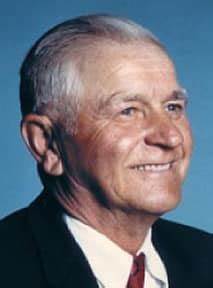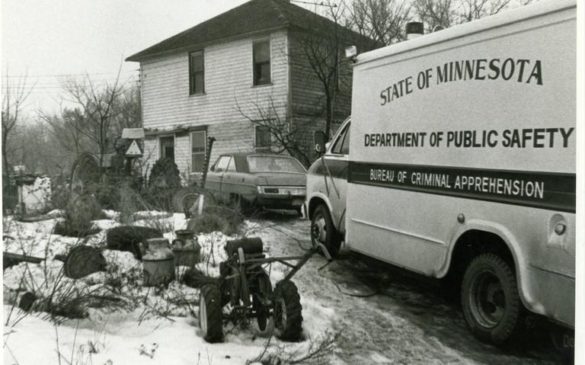 Joseph “Scriver” Olson, 75, was found dead in his rural Kandiyohi County home of February 18, 1983. He was beaten and stabbed to death. Burglary has been mentioned as a possible motive. After his death the Kandiyohi County Sheriff’s Department received an anonymous letter describing a brown pick-up truck with signage on the side parked at Olson’s house the week of the murder.
Joseph “Scriver” Olson, 75, was found dead in his rural Kandiyohi County home of February 18, 1983. He was beaten and stabbed to death. Burglary has been mentioned as a possible motive. After his death the Kandiyohi County Sheriff’s Department received an anonymous letter describing a brown pick-up truck with signage on the side parked at Olson’s house the week of the murder.
Please help bring closure to the family and friends of Joseph “Scriver” Olson, and bring his killer(s) to justice.
Anyone with information about Joseph “Scriver” Olson’s murder should contact:
The Kandiyohi County Sheriff’s office at 320-235-1260 or The Minnesota Bureau of Criminal Apprehension, Cold Case Homicide Unit at 651-793-7000
 Loading...
Loading...
40 years later, murder of Scriver Olson remains unsolved
WILLMAR — It was 35 years ago on February 18 that Ludvig Olson drove to his brother’s home across from the Crow River Lutheran Church south of Belgrade to deliver some bad news about the death of a sister-in-law.
Written By: Tom Cherveny | Feb 17th 2018 – 6am.
WILLMAR – It was 35 years ago on February 18 that Ludvig Olson drove to his brother’s home across from the Crow River Lutheran Church south of Belgrade to deliver some bad news about the death of a sister-in-law.
The news waiting for him there was far worse. He discovered that his brother had been brutally murdered.
The 1983 murder of Joseph Scriver Olson, 75, remains an unsolved homicide, but also an open case. Kandiyohi County Sheriff Dan Hartog and the sheriff’s detective assigned to the case, Kent Bauman, continues to this day to follow up on every new tip or piece of evidence that comes up.
Tips and calls still do occasionally come, and both law officers emphasize that this remains very much an open investigation. After all of these years, the knowledge of what happened may weigh heavy enough on someone to come forward, they said. It could be either the perpetrator or perpetrators or an acquaintance with inside information, but they remain convinced someone can provide the missing information to solve this homicide.
Olson was a retired farmer who had never married. He sold seed corn and monuments, and according to newspaper accounts of the time, was well liked and known throughout the Belgrade community.
He was active in the Crow River Lutheran Church. He had reportedly donated $8,000 to the church one month before his murder, according to an April 1983 account in the West Central Tribune. The same article noted that friends and neighbors who knew Olson questioned why he would be targeted by a criminal. He never carried much in the way of money, always writing checks for his purchases.
He lived by himself in a weathered home on a cluttered farm site. He did not have a telephone.
Scriver Olson’s absence from choir practice on Wednesday, Feb. 16, 1983, was the first sign that something was amiss. He also had failed to show up that day for the senior noon meal in town, even though he had signed up for it.
Authorities later disclosed that he had picked up his mail on Tuesday, but not Wednesday, leading them to believe his death had likely occurred sometime after he was last seen in Belgrade at 3:30 p.m. on Feb. 15.
Later, authorities would reveal that he had been brutally beaten and stabbed, possibly a couple of days before his brother discovered the body. The possibility that his death was the result of a burglary gone bad was among the early theories in the case. It remains one of the theories, said detective Bauman, adding that there remain a number of theories and lots of speculation on what led to the murder.
Shortly after the murder, authorities received an anonymous letter from someone stating they had seen a brown pickup truck in the victim’s driveway on Feb. 16.
Sheriff Hartog said law officers continue to keep private many of the details of the murder for investigatory reasons. It can help investigators sort fact from fiction: Only someone with actual knowledge of the murder would have information not in the public domain, they explained.
Investigators have interviewed many people and followed up countless leads through the years in hopes of putting the pieces together. Among those questioned extensively was Delbert Huber, a former neighbor of Scriver Olson. Huber died in prison in 2014, at age 83, while serving time for the fatal shooting of Timothy Larson on a farm near Belgrade in 2011.
Through the years, a number of officers with both the Kandiyohi County Sheriff’s Office and the Minnesota Bureau of Criminal Apprehension have investigated the homicide. At one point, evidence was turned over to the FBI for analysis as well.
Sheriff Hartog said new officers have deliberately been brought into the case over the years to provide a fresh set of eyes, just in case it helps catch something others may have missed. This is not a file that collects dust on a shelf, he and Bauman emphasized.
And, of course, the evidence seized at the site of Scriver Olson’s murder remains in the possession of law enforcement. There is always the possibility that some new advancement in technology could help pull new information from the evidence and provide some of the answers so long sought.
As for now, however, the two law officers believe finding the answer to who killed Scriver Olson will depend very much on someone coming forward with one or more pieces of the information that is missing. Tips are welcome by calling the sheriff’s office 320-214-6700.

Decades after Minn. murder, friend hopes killer will be identified
BELGRADE, Minn.–Sigfred Lundgren was of the first to arrive at Joseph “Scriver” Olson’s rural Belgrade home Feb. 18, 1983, to discover that Olson was dead.
Written By: Forum News Service | May 18th 2015 – 8am.
BELGRADE, Minn.-Sigfred Lundgren was of the first to arrive at Joseph “Scriver” Olson’s rural Belgrade home Feb. 18, 1983, to discover that Olson was dead.
Immediately after hearing the bad news, Lundgren’s first thought was that his 75-year-old friend possibly suffered from a heart attack. He later discovered that Olson had been brutally murdered, beaten and stabbed multiple times, the knife left at the scene.
Decades later, the murder remains a mystery and the Belgrade community still hopes that law enforcement will catch the killer, although new leads in the cold case haven’t emerged for several years.
“It would help an awful lot in our area. (Olson) was so well known in our area. He was good to many people, a kind person,” Lundgren said.
Lundgren said he does not know who would have murdered Olson, as the man was a bachelor who kept to himself. He, along with law enforcement, suspects that a burglary may have been involved with Olson’s death.
“He liked to visit with people. He got along really well with people. We still don’t have a clue who did it,” Lundgren said.
Lundgren described Olson as a kind person and a smart businessman, known throughout the community because he sold seed for a living. Besides being a businessman, Olson was devoted to his faith, an active member of the Crow River Lutheran Church.
“It was a real shock to the community. Their doors were locked and they never were before,” Lundgren said.
Law enforcement suspected Olson was murdered three days before he was found, the night Olson usually attended choir practice at his church. Lundgren was also a member of the church choir and said some of the members thought about going to check up on Olson the night he did not show up to practice.
“It’s too bad we didn’t. It was really foggy that night,” Lundgren said.
Days later, while he was performing chores around the house, Lundgren was again alerted that something might be wrong.
After he received a call from a concerned neighbor who said there had not been an answer at Olson’s door, Lundgren went with a neighbor to check on Olson.
Lundgren was greeted at the house by Ludvig Olson, Olson’s brother, who had made the trip to Olson’s house to deliver news that a relative had died. He arrived to find his brother dead.
Lundgren also spotted a broken window and Olson’s dog, that was acting strange and had its tail between its legs.
While Lundgren hopes a suspect in the murder will be eventually identified, he said he tries not to spend time dwelling on the tragedy.
“There were some people in our area that were very angry…I’m more calm. There isn’t much you can do about it if (law enforcement) can’t figure it out,” Lundgren said.
While local law enforcement has not received many new leads on the case during the past several years, Kandiyohi County Sheriff Dan Hartog remains hopeful that the case will be cracked.
“We don’t forget about it. We want to find the person who did this to Scriver and put closure to it,” Hartog said.
All detectives who initially worked on the case have since retired. Kent Bauman, the detective currently assigned to the case, said he still occasionally receives information on the case and follows up on all new tips.
“We’ve looked at some old names, we’ve revisited some theories and suspects to see if there is anything new we can add to the case,” Bauman said.
New leads have been hard to come by, but just one new lead could help solve the murder, Hartog said.
“I think it just takes the right piece of information,” Hartog said.
Local law enforcement continues to work with the Bureau of Criminal Apprehension reviewing evidence. Hartog said future advances in technology could be the key that unlocks the mystery of the case.
While DNA evidence has been entered into the BCA’s database, law enforcement has been unable to match the information with a suspect.
Hartog said he could not go into specifics, but said “technology could help” identify the killer.
The BCA issued a $50,000 reward in 2002 for information that leads to the arrest and conviction of the person or persons responsible for the murder.
The reward still remains in effect today. The Olson case is also featured on the BCA’s Spotlight on Crime website at spotlightoncrime.org.
Hartog urges those with any information regarding the case to contact the Kandiyohi County Sheriff’s Office at 320-214-6700.
“If there is anyone out there with information, please come forward,” Hartog said. “The case is still open and we are just looking for that break to find the person that did this.”
Larson v. State
Annotate this Case
451 N.W.2d 213 (1990)
Norman R. LARSON, Appellant, v. STATE of Minnesota, Respondent, Kandiyohi County, Defendant.
No. C6-89-1309.
Court of Appeals of Minnesota.
February 6, 1990.
John E. Mack, New London, for appellant.
Hubert H. Humphrey, III, State Atty. Gen., David T. Schultz, Special Asst. Atty. Gen., St. Paul, for respondent.
Considered and decided by CRIPPEN, P.J., and KLAPHAKE and FLEMING, JJ.
OPINION
KLAPHAKE, Judge.
Appellant was questioned pursuant to a murder investigation. He brought suit against the state and county claiming the law enforcement officers’ conduct during the investigation was outrageous and their comments to a reporter slandered him. Claims against the county were settled out of court. The state moved for summary judgment on the grounds (1) the claims were barred by the statute of limitations, (2) the alleged defamatory statements were true and not defamatory as a matter of law, and (3) the state’s conduct was not outrageous as a matter of law. The trial court granted the state’s motion, and appellant appeals.
FACTS
Scriver Olson was found murdered in his home in rural Kandiyohi County on February *214 18, 1983. Appellant Norman Larson, a neighbor and friend of Olson, was questioned by authorities a number of times during the following year in connection with the murder. In the course of the investigation, conducted by the Kandiyohi County Sheriff’s Department and the State Bureau of Criminal Apprehension (BCA), appellant became a principal suspect.
Interviews with appellant took place over the phone, at appellant’s home, in the victim’s home, at the cemetery where the victim was buried and at the Holiday Inn in Willmar. On two occasions, in February and March 1983, authorities requested, and appellant consented to give them, several items of clothing and personal property to be sent to the BCA lab for testing. Appellant alleges that on September 27, 1983, in the presence of a reporter, BCA agent Sigafoos slandered appellant by stating he was the “number one suspect” in the case, and that most of the BCA file on the case contained information about appellant. Appellant further alleges that the authorities harassed him by their phone calls night and day and by telling him “the spirit of Scriver Olson would haunt him forever unless he confessed.” Appellant also claims the tactics of the authorities were “designed to prey on his mental weaknesses,” a mental fragility evidenced by appellant’s temporary commitment in 1981 to the Willmar State Hospital.
Pursuant to Minn.Stat. § 3.736, subd. 5 (1984), appellant filed notice of his tort claims with the State Attorney General (respondent). Notice was served in July 1985, although commencement of the action by service of the summons and complaint was not accomplished until December 19, 1985. Respondent denied the allegations of defamation and outrage. The parties, however, agreed to suspend discovery indefinitely because the murder investigation had not yet been completed.
Appellant filed a certificate of readiness in January 1987, and, upon a court order, filed a more definite statement setting forth the alleged defamatory statement and the date upon which it was uttered. The case was transferred from Ramsey County to Kandiyohi County in June 1988. In September 1988, the trial judge ordered the parties to proceed with discovery. Appellant’s deposition was taken on October 17 and November 25, after which respondent moved to amend its answer in order to plead the statute of limitations. The court granted the motion and discovery was continued.
Respondent’s motion for summary judgment was heard on February 15, 1989. The trial court granted the motion on all claims, and appellant brings this challenge.
ISSUES
I. Did the trial court err in holding appellant’s tort claims were barred by the two year statute of limitations period set forth in Minn.Stat. § 541.07(1)?
II. If the statute of limitations does not bar appellant’s claims, did the trial court err in granting respondent’s motion for summary judgment because it found no facts in dispute on the issues of defamation and intentional infliction of emotional distress?
ANALYSIS
On appeal from summary judgment it is the function of the reviewing court to determine whether there are any genuine issues of material fact and whether the trial court erred in its application of the law. Betlach v. Wayzata Condominium, 281 N.W.2d 328, 330 (Minn.1979). This court “must take a view of the evidence most favorable to the one against whom the motion was granted.” Abdallah, Inc. v. Martin, 242 Minn. 416, 424, 65 N.W.2d 641, 646 (1954) (citations omitted).
Actions for “libel, slander, assault, battery, false imprisonment, or other tort, resulting in personal injury” shall be commenced within two years after the cause of action accrues. Minn.Stat. § 541.07(1) (1984). See also Minn.Stat. § 541.01. The events giving rise to appellant’s action for defamation and intentional infliction of emotional distress occurred between February and November 1983, with the exception of police calls to appellant in March 1984 in regard to a fire at Scriver Olson’s home. *215 Appellant served his summons and complaint on the state in December 1985, more than two years after all but one of the investigative actions at issue.
Appellant contends the statute of limitations does not apply because (1) it was tolled by appellant’s mental disability and (2) the notice provision of the Minnesota Tort Claims Act acts as a statutory bar to the suit. Appellant also argues the trial court erred in allowing respondent to amend its answer in December 1988 to assert the statute of limitations defense.
A plaintiff’s insanity, if “existing at the time when a cause of action accrued or arising anytime during the period of limitation, shall suspend the running of the period of limitation until the same is removed.” Minn.Stat. § 541.15(2) (1984).
[I]nsanity means substantial inability, by reason of mental defect or deficiency, to understand one’s legal rights, manage one’s affairs, and prosecute the claim. As a corollary to this rule, we conclude that short, temporary occasions of mental illness are sufficient to toll the statute on the basis of “insanity” only if such short occasions substantially impair the general ability of the plaintiff to understand her rights, manage her affairs, and prosecute the claim. This determination of substantial impairment depends upon the duration of the mental illness or defect as compared to the time within which suit must be brought.
Views: 17








 Total Users : 5715722
Total Users : 5715722